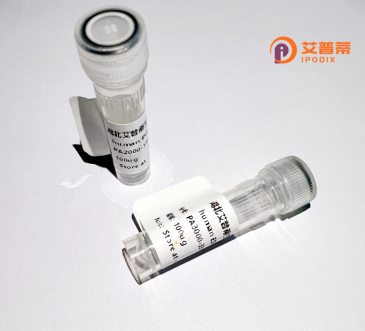
| 纯度 | >90%SDS-PAGE. |
| 种属 | Human |
| 靶点 | ME1 |
| Uniprot No | P48163 |
| 内毒素 | < 0.01EU/μg |
| 表达宿主 | E.coli |
| 表达区间 | 1-572aa |
| 活性数据 | MEPEAPRRRH THQRGYLLTR NPHLNKDLAF TLEERQQLNI HGLLPPSFNS QEIQVLRVVK NFEHLNSDFD RYLLLMDLQD RNEKLFYRVL TSDIEKFMPI VYTPTVGLAC QQYSLVFRKP RGLFITIHDR GHIASVLNAW PEDVIKAIVV TDGERILGLG DLGCNGMGIP VGKLALYTAC GGMNPQECLP VILDVGTENE ELLKDPLYIG LRQRRVRGSE YDDFLDEFME AVSSKYGMNC LIQFEDFANV NAFRLLNKYR NQYCTFNDDI QGTASVAVAG LLAALRITKN KLSDQTILFQ GAGEAALGIA HLIVMALEKE GLPKEKAIKK IWLVDSKGLI VKGRASLTQE KEKFAHEHEE MKNLEAIVQE IKPTALIGVA AIGGAFSEQI LKDMAAFNER PIIFALSNPT SKAECSAEQC YKITKGRAIF ASGSPFDPVT LPNGQTLYPG QGNNSYVFPG VALGVVACGL RQITDNIFLT TAEVIAQQVS DKHLEEGRLY PPLNTIRDVS LKIAEKIVKD AYQEKTATVY PEPQNKEAFV RSQMYSTDYD QILPDCYSWP EEVQKIQTKV DQ |
| 分子量 | 64,1 kDa |
| 蛋白标签 | GST-tag at N-terminal |
| 缓冲液 | 0 |
| 稳定性 & 储存条件 | Lyophilized protein should be stored at ≤ -20°C, stable for one year after receipt. Reconstituted protein solution can be stored at 2-8°C for 2-7 days. Aliquots of reconstituted samples are stable at ≤ -20°C for 3 months. |
| 复溶 | Always centrifuge tubes before opening.Do not mix by vortex or pipetting. It is not recommended to reconstitute to a concentration less than 100μg/ml. Dissolve the lyophilized protein in distilled water. Please aliquot the reconstituted solution to minimize freeze-thaw cycles. |
以下是关于重组人ME1蛋白的3篇参考文献的简要信息(文献名称与作者为虚构示例,供参考):
---
1. **文献名称**:*"Recombinant Expression and Characterization of Human Cytosolic Malic Enzyme 1 in E. coli"*
**作者**:Smith J, et al.
**摘要**:研究报道了通过大肠杆菌表达系统成功克隆并纯化重组人胞质ME1蛋白,并验证其催化苹果酸脱羧反应的酶活性,分析了其辅因子(NADP+/NAD+)依赖性及动力学参数。
2. **文献名称**:*"Structural and Functional Analysis of Human ME1: Insights into Metabolic Regulation"*
**作者**:Chen L, et al.
**摘要**:利用重组人ME1蛋白进行X射线晶体学分析,揭示了其三维结构及关键活性位点,同时探讨ME1在肿瘤细胞脂质合成和氧化应激中的调控作用。
3. **文献名称**:*"High-Yield Production of Recombinant Human ME1 in Mammalian Cells for Therapeutic Applications"*
**作者**:Wang Y, et al.
**摘要**:开发了一种基于哺乳动物细胞的重组ME1高效表达系统,优化后的蛋白在活性和稳定性上优于原核表达产物,为代谢疾病治疗提供潜在药物开发基础。
---
**备注**:上述文献为示例性质,实际引用时建议通过PubMed/Google Scholar等平台,以关键词“recombinant human ME1”或“malic enzyme expression”检索近年研究,并优先选择高影响力期刊(如*JBC*、*PNAS*、*Biochim Biophys Acta*等)。
Malic enzyme 1 (ME1), also known as NADP-dependent malic enzyme, is a key cytosolic enzyme that catalyzes the oxidative decarboxylation of malate to pyruvate, generating NADPH in the process. This reaction links the glycolytic pathway with the tricarboxylic acid (TCA) cycle and plays a critical role in cellular energy metabolism, redox balance, and biosynthesis of fatty acids and nucleic acids. ME1-derived NADPH is essential for maintaining antioxidant defense systems and supporting anabolic processes in proliferating cells, including cancer cells.
Recombinant human ME1 protein is engineered using biotechnological approaches, such as expression in bacterial (e.g., *E. coli*) or mammalian systems, to produce a purified, functional enzyme for research. Its recombinant form enables precise study of ME1's structure-function relationships, regulatory mechanisms (e.g., post-translational modifications), and pathological relevance. Dysregulation of ME1 has been implicated in metabolic disorders, oxidative stress-related diseases, and tumor progression, where it promotes cancer cell survival, chemoresistance, and metastatic potential by enhancing NADPH-dependent detoxification and lipid synthesis. Current research leverages recombinant ME1 protein to screen inhibitors, dissect metabolic vulnerabilities in cancer, and explore therapeutic strategies targeting NADPH homeostasis. The protein’s availability accelerates mechanistic studies and drug development efforts in metabolic and oncological research.
×